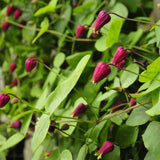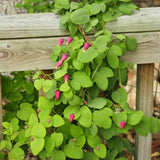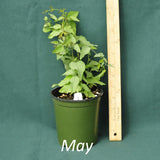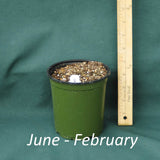More plants available in February 2026
Clematis glaucophylla is a rare native vine with attractive leaves and hot pink flowers that can bloom through most of the summer.
- Pollinated by hummingbirds and bumblebees
- Easy to grow
- Well-behaved habit
Details
- Twining vine
- Plants die back in the fall and rise again in early spring
- 8 to 12 feet tall
- Hardy in USDA hardiness zones 6, 7, 8, and 9
Flowering period
In central North Carolina, flowering starts in May and can continue through the summer if plants receive a steady supply of moisture.
How to grow
Planting in moist, rich soil will be rewarded with ample growth and lots of flowers. It prefers part shade but will grow in full sun with adequate moisture.
Care and maintenance
Flowers are formed on new growth so stems can be cut to the ground anytime in winter. To extend flowering through the summer, water during dry spells.
Pine voles can be a problem eating the crowns of Clematis. To protect plants, create a cylinder with hardware cloth (½ inch or smaller mesh) and plant the Clematis inside it. Make sure the hardware cloth is buried at least 6 inches deep to protect it from burrowing voles.
Where to plant
On trellises, arbors, along porch railings, and even in large containers.
When to plant
Best in spring or fall, but can be planted in the summer if plants are kept well-watered until they get established.
When will my plant flower?
Flowering-sized plants that will flower their first year.
Spacing
Around 6 feet apart.
Native habitat and range
Rare native, growing in woodland openings at scattered locations throughout the Southeastern United States.
Source and origin
Plants are grown from seeds here at the nursery. The original seeds came from Blount County, Tennessee.
| States | Orders up to $50 | Orders $51 to $100 | Orders over $100 |
| AL, DE, GA, KY, MD, NC, OH, PA, SC, TN, VA, and WV | $16 | $18 | $20 |
| AR, CT, FL, IL, IN, LA, MA, MI, MO, MS, NH, NJ, NY, RI, VT, and WI | $18 | $20 | $22 |
| IA, KS, ME, MN, OK, and TX | $20 | $22 | $24 |
| CO, NE, ND, and SD | $22 | $24 | $26 |
Sorry, we can't ship plants outside of the continental United States or to AK, AZ, CA, HI, ID, NM, NV, OR, UT, and WA due to agriculture restrictions.
When will my order be shipped?All plants are shipped within two weeks of placing an order.
Is it okay to plant in the winter?Yes, as long as the soil is not frozen. Planting native perennials in winter and early spring gives your plants a head start before the summer heat arrives.
What if it’s too cold to plant where I live, but I want to buy a plant before it sells out?Dormant plants can safely be kept in a basement, garage, or cool room until you are ready to plant in late winter or early spring.
How will my plants get delivered?Most orders are shipped on Monday or Tuesday via UPS Ground, which depending on the destination takes between 1 to 4 days.
Are your plants shipped in their containers?Yes, all our plants are shipped in their growing containers. The majority are grown in containers that are 4.5 inches wide by 5 inches deep and 32 fl. oz. / 946 ml in volume.
Do you guarantee your plants?We guarantee our plants to be healthy, ready for planting and correctly named. We are not able to guarantee whether a plant will grow in your garden as there are too many circumstances that are beyond our control.
On rare occasions, a plant shipped dormant may fail to emerge from its dormancy. If this happens, please let us know. If you are concerned about a plant, please contact us within 14 days to let us know. If we can’t help you make it grow, we’ll send you a new plant or issue a refund.
You can return your plants if you no longer want them once they arrive. To receive a refund (minus 20% restocking fee) the plants must be returned in good condition. Return shipping is the customer’s responsibility.
Can I cancel my order?Yes, you can cancel your order. Please visit our terms and service page for details.
What about sales tax?We propagate our own plants and are not required to collect North Carolina sales tax.
Where can I find information about your plants?Here are some FAQ on how we grow plants.











